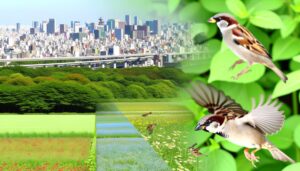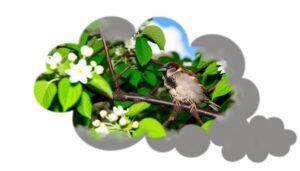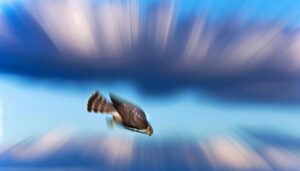10 Steps to Remove a Sparrow Nest with Eggs Safely
Removing a sparrow nest with eggs demands careful adherence to legal and ethical standards. First, confirm the species and consult local wildlife authorities to guarantee compliance with regulations, such as the Migratory Bird Treaty Act.
Prepare by gathering essential tools like padded gloves, long-handled tongs, and a portable container. Approach the nest quietly, using gentle handling to minimize stress.
Relocate the nest to a suitable nesting box, guaranteeing it mimics the original environment. Monitor the new location to guarantee successful relocation.
To learn more about the detailed steps and tools required, continue exploring this subject.
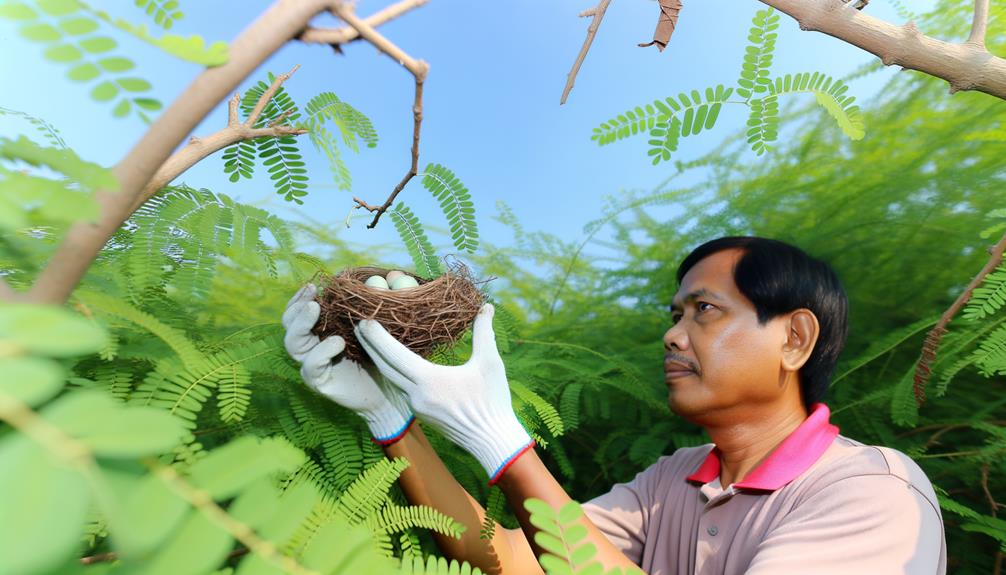
Key Takeaways
- Verify the legality of nest removal and obtain necessary permits.
- Monitor the nest to ensure it is inactive, ideally during the non-breeding season.
- Wear protective gear, including gloves, mask, and goggles, to handle the nest safely.
- Use long-handled tongs and a portable container for gentle nest and egg relocation.
- Place the nest in a suitable nesting box that mimics the original environment.
Understanding Sparrow Nesting Habits
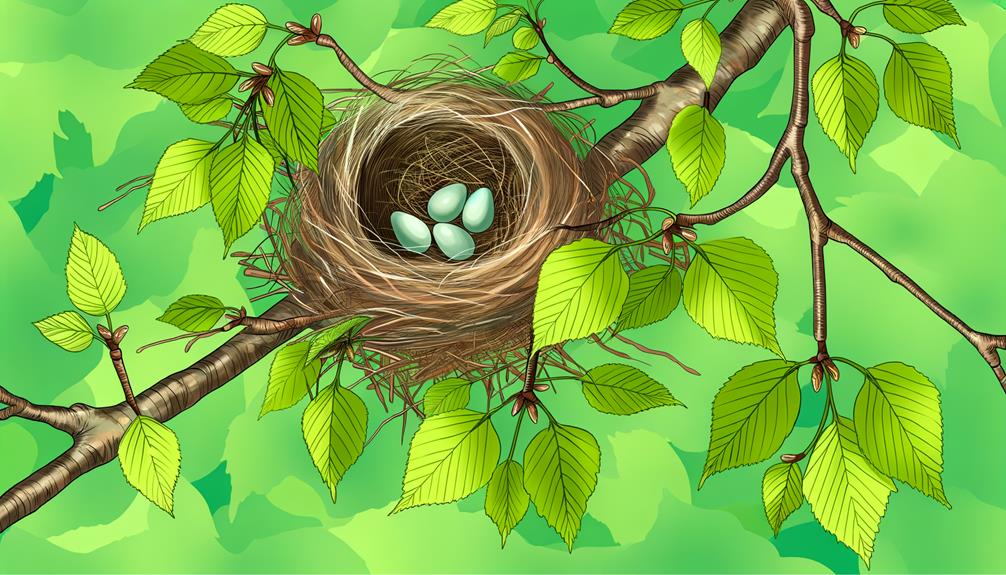
Sparrows display specific nesting habits characterized by their preference for sheltered locations and their tendency to build nests using a variety of natural and urban materials. These small birds often choose sites such as eaves, rafters, and even man-made structures like streetlights and building vents. Their nests are typically made from grasses, twigs, feathers, and other available debris.
Sparrows are prolific breeders, often producing multiple broods in a single season. Understanding these nesting behaviors is vital for effective nest management and intervention. This knowledge helps in identifying potential nesting sites and predicting nesting cycles.
Ethical considerations must be taken into account to minimize disturbance and ensure compliance with wildlife protection regulations while managing sparrow populations.
Legal Considerations
When considering the removal of a sparrow nest with eggs, it is important to understand the legal protections and regulations that govern such actions.
Various laws, including the Migratory Bird Treaty Act (MBTA) in the United States, often protect bird species and their nests. While House Sparrows (Passer domesticus) are typically exempt from these protections due to their non-native status, local regulations may still apply.
It is essential to confirm the species of sparrow and consult local wildlife authorities before proceeding. Ethical considerations should also be weighed, as nest removal can impact the birds' reproductive success and survival.
Understanding and complying with legal and ethical standards guarantees responsible and humane handling of wildlife.
Assessing Nest Location
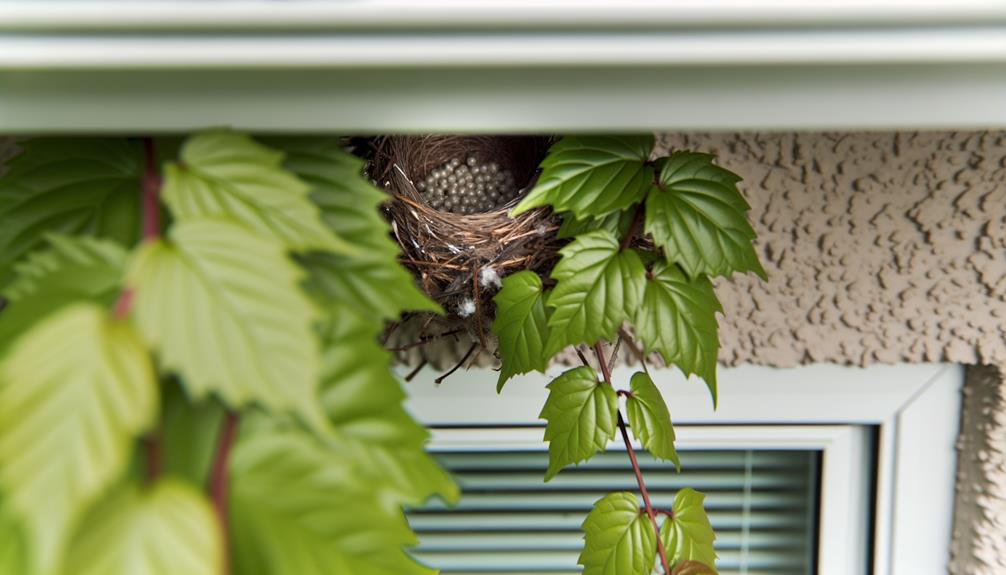
Evaluating the location of the sparrow nest is crucial for ensuring both the safety of individuals and the welfare of the birds. Key factors include examining the accessibility and safety of the site, understanding the nest's impact on property infrastructure, and considering its proximity to human activity.
A thorough evaluation will guide ethical and effective removal, minimizing harm to the birds and mitigating potential hazards to people and property.
Accessibility and Safety Concerns
Identifying the precise location of the sparrow nest is crucial for guaranteeing both human and avian safety during the removal process. Begin by carefully observing the area where sparrows are frequently seen entering or exiting.
Assess the accessibility of the nest, considering factors such as height, structural stability, and potential hazards like electrical wiring or sharp objects. Use appropriate safety gear, including gloves and protective eyewear, to mitigate risks.
Additionally, make sure that the removal process does not inadvertently harm the nestlings or the adult birds. Ethical considerations should guide the method and timing of removal, prioritizing the well-being of the sparrows while addressing human safety concerns.
Proper planning and precautionary measures are paramount for a safe and humane removal.
Nest Impact on Property
Understanding the potential impact of a sparrow nest on property involves a thorough evaluation of its location, considering factors such as structural integrity, possible damage to surfaces, and interference with human activities. Specifically, nests situated in gutters or drainage systems can obstruct water flow, leading to water damage and potential structural compromise.
Additionally, nests built under eaves or in ventilation systems can block airflow, causing inefficiencies and potential overheating. The accumulation of nesting materials and droppings can also degrade surfaces, necessitating maintenance and repairs.
Evaluating the exact placement of the nest is essential for determining the extent of potential damage and formulating an appropriate removal strategy that balances property protection with ethical considerations for the sparrows.
Proximity to Human Activity
Given the potential for human-wildlife conflict, evaluating the proximity of a sparrow nest to areas of frequent human activity is crucial for determining both the risk to the nest and the impact on daily routines. Sparrows often select nesting sites that offer some protection, yet nests located near windows, doors, or high-traffic areas can lead to disturbances.
Human activities may inadvertently stress the birds, potentially causing abandonment of the nest and eggs. Conversely, nests too close to human activity can pose sanitation and health concerns. Ethical considerations demand a balanced approach to ensure minimal disruption to the birds while safeguarding human health.
Detailed assessment of the nest location should inform any decisions regarding its removal or relocation.
Preparing Safe Relocation
To guarantee the safe relocation of a sparrow nest with eggs, it is essential to select an appropriate nesting box that mimics the original environment.
The timing of the relocation must be carefully planned to minimize stress and potential harm to the birds.
Additionally, meticulous care must be taken to handle the nest and eggs gently, preserving the integrity of the nest structure and the well-being of the developing embryos.
Choosing Nesting Box
Choosing an appropriate nesting box is crucial for the ethical and successful relocation of a sparrow nest with eggs. A suitable nesting box ensures that the sparrows experience minimal stress and disruption during the transfer process. Key factors to take into account include size, material, and ventilation. The box should replicate the natural habitat and provide adequate protection against predators and environmental elements. Below is a comparative table highlighting the specifications of recommended nesting boxes:
| Feature | Ideal Measurement | Importance |
|---|---|---|
| Size | 12x12x15 inches | Comfort and space for growth |
| Material | Untreated wood | Safety and non-toxicity |
| Ventilation | Multiple small holes | Prevents overheating and humidity |
| Entrance Hole | 1.5 inches in diameter | Allows access while deterring predators |
Selecting the appropriate box promotes a supportive environment for the sparrows' development.
Timing and Care
Proper timing and meticulous care are paramount when preparing to safely relocate a sparrow nest with eggs. The best period for relocation is either early morning or late evening when sparrows are less active. Ensuring minimal disturbance is critical; consequently, approach the nest slowly and quietly.
Carefully transfer the nest to a pre-selected nesting box, mimicking the original environment as closely as possible. It is imperative to handle the eggs with utmost gentleness, avoiding any physical damage. Use gloves to prevent transferring human scent, which might cause the parents to abandon the nest.
Post-relocation, monitor the nest discreetly to make sure that the parent sparrows accept the new location and continue their caretaking activities unhindered.
Gathering Necessary Tools
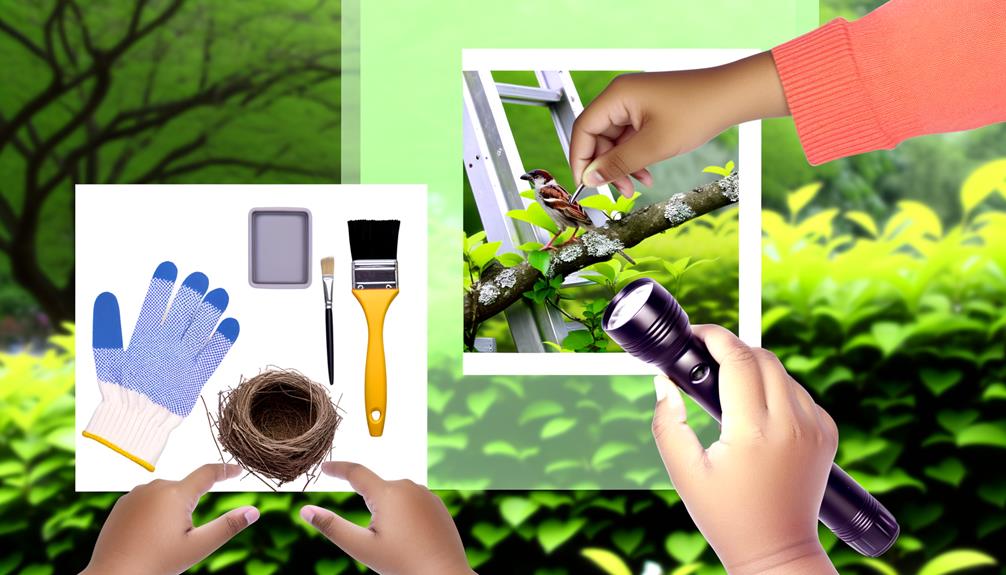
A thorough approach to gathering necessary tools for safely removing a sparrow nest with eggs involves selecting equipment that secures both human safety and minimal disturbance to the birds. Essential tools include:
- Soft, padded gloves: To handle the nest delicately and avoid transferring human scent.
- Long-handled tongs: Allow for gentle nest removal from hard-to-reach locations while maintaining a safe distance.
- Portable container: A small, ventilated box to temporarily house the nest and eggs if relocation is necessary.
- Ladder: Guarantees safe access to elevated nests, reducing the risk of accidental falls.
These tools must be chosen with care to uphold ethical standards and secure that the process is conducted with the utmost respect for wildlife.
Wearing Proper Protective Gear
When removing a sparrow nest containing eggs, wearing proper protective gear is crucial to guarantee safety and ethical handling.
Crucial safety equipment, such as gloves and masks, helps prevent potential hazards, including allergenic reactions and exposure to pathogens.
Additionally, using biodegradable materials in protective gear aligns with environmental best practices, minimizing ecological impact.
Essential Safety Equipment
Using appropriate protective gear is vital to ensure both personal safety and the humane treatment of the sparrows during the nest removal process. Proper equipment minimizes the risk of injury and reduces stress on the birds.
Necessary safety equipment includes:
- Gloves: Wear thick, puncture-resistant gloves to safeguard your hands from bites and scratches.
- Safety Goggles: Shield your eyes from dust, debris, and potential pecks.
- Face Mask: Prevent inhalation of harmful particles such as bird droppings and feathers, which may carry pathogens.
- Protective Clothing: Utilize long-sleeved shirts and long pants to cover exposed skin and reduce the risk of contamination or injury.
Using these protective measures guarantees a safe and ethical approach to nest removal.
Preventing Potential Hazards
Ensuring the correct use of protective gear is vital in mitigating potential hazards associated with the removal of a sparrow nest containing eggs.
Protective gloves should be worn to prevent direct contact with potential allergens, bacteria, or parasites present in the nest material.
Safety goggles are essential to shield eyes from particulate matter and possible avian pathogens.
A dust mask or respirator can protect against inhalation of harmful particles and allergens.
Long-sleeved clothing and pants help to minimize skin exposure.
The use of such protective measures is essential not only for personal safety but also to maintain ethical standards by reducing stress on the birds and ensuring a humane approach to nest removal.
Proper attire is non-negotiable for safe, responsible execution.
Handling Biodegradable Materials
Proper handling of biodegradable materials during the removal of a sparrow nest with eggs requires the use of appropriate protective gear to prevent contamination and guarantee safety. Ensuring that you are adequately protected minimizes the risk of exposure to pathogens and allergens present in bird nests.
The following protective gear is recommended:
- Gloves: Use nitrile or latex gloves to avoid direct contact with organic material.
- Masks: Wear an N95 mask to filter airborne particles and potential allergens.
- Safety Goggles: Protect your eyes from dust and debris that may be disturbed during the removal process.
- Protective Clothing: Don long-sleeved shirts and pants to reduce skin exposure.
Timing the Removal
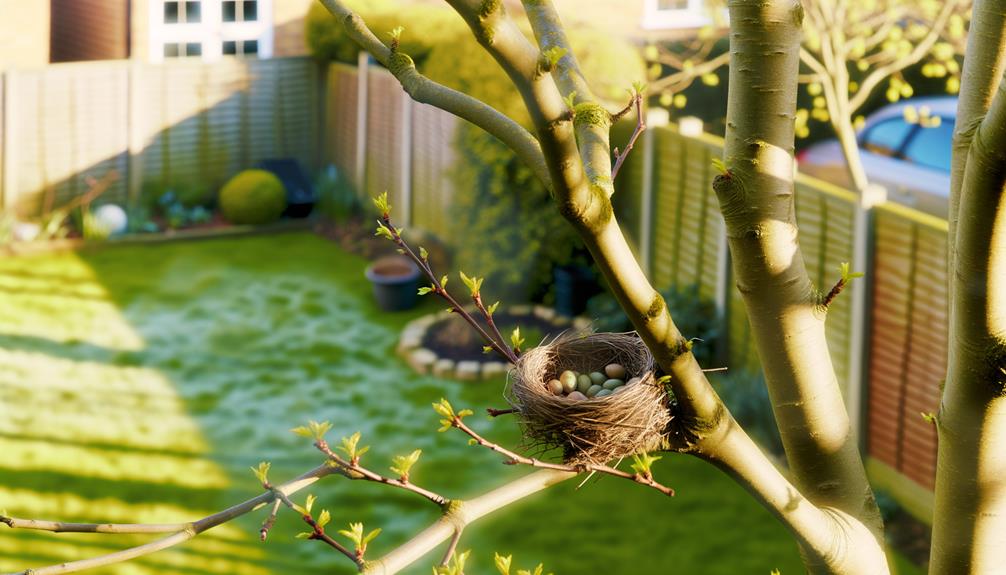
Determining the best timing for removing a sparrow nest with eggs is significant to minimize harm to the birds and comply with wildlife protection regulations. Ideally, removal should occur during the non-breeding season, typically from late fall to early winter, when nests are unoccupied.
Monitoring the nest to confirm it is inactive is vital; this involves observing for at least a week to verify no adult sparrows are attending. Ethical considerations also mandate checking local laws, as many regions provide legal protections for nesting birds. In certain cases, permits may be required for removal.
Removing the Nest
When it comes to removing a sparrow nest with eggs, meticulous preparation and adherence to ethical guidelines are paramount. To guarantee a humane and scientifically sound process, careful steps must be followed:
- Assess Legality: Verify local wildlife protection laws to secure compliance.
- Wear Gloves: Use gloves to prevent human scent transfer and shield from potential pathogens.
- Prepare Materials: Gather a well-ventilated container lined with soft material for temporary housing.
- Minimize Disturbance: Approach the nest quietly and gently to lessen stress on the birds.
Relocating the Nest

Ensuring the successful relocation of a sparrow nest with eggs requires a methodical approach that prioritizes the birds' welfare and habitat integrity. The process involves selecting an appropriate new site that mirrors the original environment, guaranteeing minimal disturbance to the nest. Handling the nest delicately to avoid harm to the eggs is vital. It is advisable to move the nest during early morning or late evening, when sparrows are less active. Additionally, making sure the new location is protected from predators and harsh weather conditions is essential. The following table outlines key considerations:
| Consideration | Description | Importance |
|---|---|---|
| Location Selection | Mimic original surroundings | Ensure familiarity and safety |
| Timing | Early morning or late evening | Minimize disruption |
| Handling | Gentle and cautious | Prevent egg damage |
| Safety | Protected from predators and weather | Enhance survival |
| Legal Compliance | Adhere to wildlife protection laws | Ethical and legal responsibility |
Monitoring the New Location
Observing the new location is crucial to secure the continued safety and well-being of the relocated sparrow nest and its eggs. Regular supervision guarantees that the nest remains undisturbed and that the eggs are developing normally.
Key aspects to monitor include:
- Predator Activity: Check for signs of predators such as cats, snakes, or larger birds that may pose risks.
- Environmental Stability: Confirm the new location maintains suitable temperature, humidity, and shelter from adverse weather conditions.
- Human Disturbance: Validate that the nest is in a low-traffic area to minimize stress and disruption.
- Parental Return: Observe if the parent sparrows are visiting the nest regularly, indicating acceptance of the new location.
Such attentive monitoring will help secure the sparrows thrive.
Preventing Future Nesting
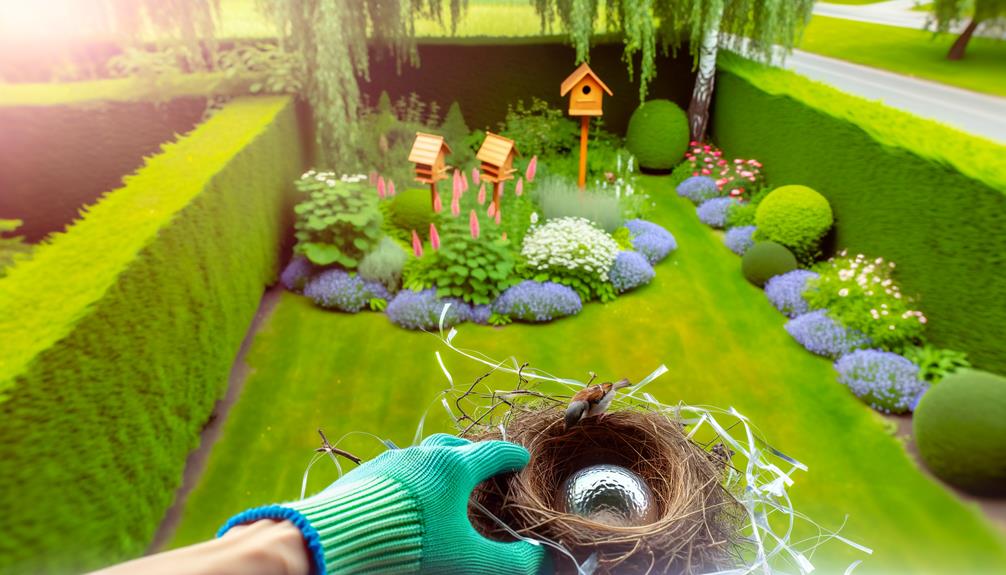
Implementing deterrent strategies is crucial to prevent sparrows from establishing nests in undesirable locations in the future.
One effective method is to install bird spikes or netting in areas where sparrows are likely to nest, such as eaves or ledges.
Additionally, consider using visual deterrents like reflective tape or predator decoys.
Regularly inspect and seal potential entry points, including gaps in roofs and walls.
Providing alternative nesting sites, such as birdhouses placed away from human activity, can also redirect their nesting behavior.
It is important to conduct these activities ethically, making sure that deterrents do not harm the birds.
Consistent maintenance and monitoring will help guarantee that sparrows do not re-establish nests in the targeted areas.
Conclusion
The process of removing and relocating a sparrow nest with eggs necessitates a thorough understanding of their nesting habits, adherence to legal regulations, and meticulous execution to guarantee the birds' safety.
By methodically preparing and employing the appropriate tools, one can ethically relocate the nest, akin to carefully transplanting a delicate seedling to fertile soil, ensuring continued growth and survival.
Vigilant monitoring and preventive measures further safeguard against future nesting disruptions.

